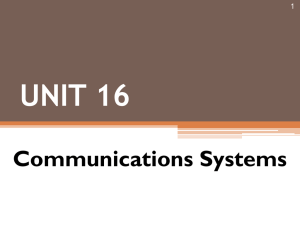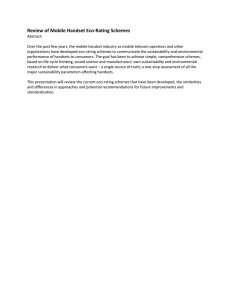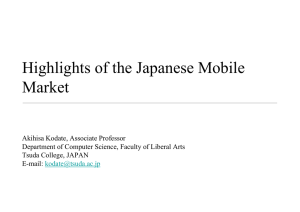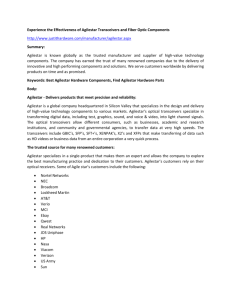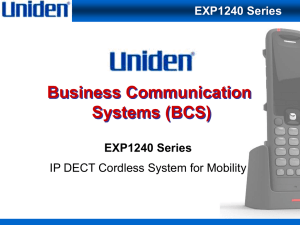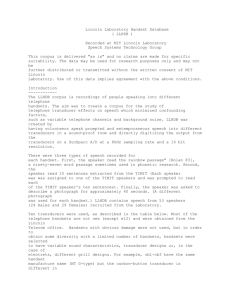Mobile Handset RF (Radio Frequency) IC Industry Report, 2007-2008
advertisement
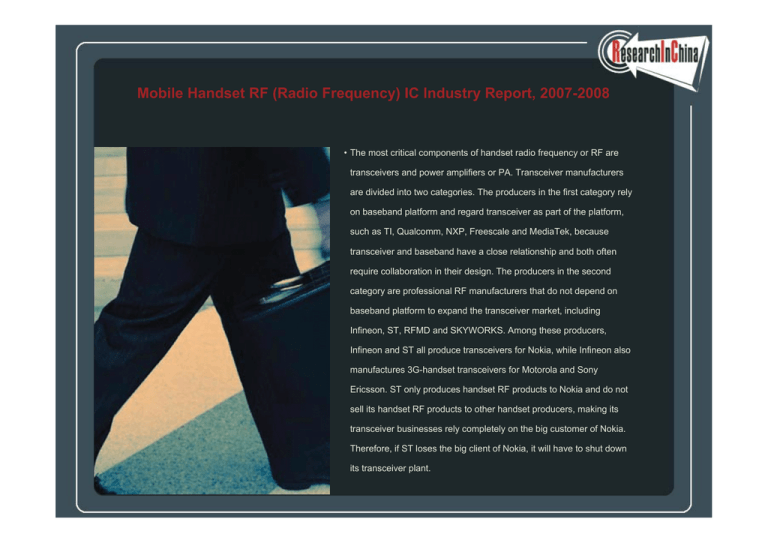
Mobile Handset RF (Radio Frequency) IC Industry Report, 2007-2008 • The most critical components of handset radio frequency or RF are transceivers and power amplifiers or PA. Transceiver manufacturers are divided into two categories. The producers in the first category rely on baseband platform and regard transceiver as part of the platform, such as TI, Qualcomm, NXP, Freescale and MediaTek, because transceiver and baseband have a close relationship and both often require collaboration in their design. The producers in the second category are professional RF manufacturers that do not depend on baseband platform to expand the transceiver market, including Infineon, ST, RFMD and SKYWORKS. Among these producers, Infineon and ST all produce transceivers for Nokia, while Infineon also manufactures 3G-handset transceivers for Motorola and Sony Ericsson. ST only produces handset RF products to Nokia and do not sell its handset RF products to other handset producers, making its transceiver businesses rely completely on the big customer of Nokia. Therefore, if ST loses the big client of Nokia, it will have to shut down its transceiver plant. • RFMD and SKYWORKS both have lost interest in transceiver business, the ratio of transceiver business to their total is low, especially that of RFMD. From the perspective of the current situation, it will be very hard for RFMD and SKYWORKS to keep their transceiver business without the support of mobile phone platform, so they will have to either sell it or shut it down. SILABS sold its transceiver business to NXP in 2007. In fact, SILABS transceiver business with LG, Samsung and Amoi as its loyal clients was excellent. By relying on baseband, MediaTek has expanded its global market share of transceiver from less than one percent in 2005 to the current more than 12 percent, ranking the fifth in the world. • Transceivers are advancing towards integration and multi-mode. Integration is the requirement of handset manufacturers for decreasing the cost continuously. The semiconductor manufacturing technique of transceivers has changed from BiCMOS in early 2000 to the current RF CMOS. The single-mode transceiver is completely integrated into the baseband. If handset baseband manufacturers can not make it, they will easily become disadvantageous in the competition. Infineon and Broadcom have excellent performance in this aspect. The reason why NXP acquired the transceiver business of SILABS is to make up for its shortcoming in this aspect. Multi-mode is a challenge to manufacturers. In the future, mobile phone producers are most likely to adopt multimode, such as WCDMA, LET and WIMAX, in their 3G and 4G mobile phones. Mobile phone producers with poor technological strength will be driven out of the market. • We believe that manufacturers that are making attempts to make a foray into the handset transceiver field cannot succeed, because it is not a field, where emerging producers and small manufacturers can survive. Although they have the chance to be taken over by big manufacturers, they will have used up funds of venture capitalists before being merged. • Power amplifier is an independent field with market entry threshold. PA, as the most important component of a mobile phone, can not be integrated. Handset's call quality, signal receiving ability and battery life are all decided by PA. Generally speaking, once a handset manufacturer chooses a PA supplier, it is almost not possible for the manufacture to change the supplier. Many emerging producers are trying to replace the current PA with GaAs-based PHEMT technique by one with silicon-based CMOS technology, which is nearly impossible. No matter how much manufacturers can accept the new technology, CMOS technology does not have the advantage in cost. Because CMOS technology is only lower in wafer cost, its total cost is not advantageous at all. The purchase cost of one 6-inch GaAs wafer is around US$500, while that of one 8-inch silicon wafer is less than US$50. However, one 6-inch GaAs wafer can produce 5,000 to 10,000 PA, so averagely, the cost per chip is not that high as imagined, just a tiny higher. If the cost of IC packaging & testing and design is added, the total cost of silicon-based CMOS PA will be surely a lot higher than that of GaAs-based PHEMT PA. The biggest difference between GaAs and silicon lies in electron mobility. The speed of GaAs electron mobility is two to six times of that of silicon, so its ability of processing high-speed and high-frequency signals is higher, thus making its performance in a dominant position. The main PA manufacturers are RFMD, SKYWORKS, RENESAS, NXP, AVAGO, TRIQUINT, and ANADIGICS. • In 2007, Media Tek shipment in Mainland China decreased, due to the short supply of PA. The design manual of MediaTek recommended handset manufacturers to adopt the power amplifiers of Reneseas and RFMD. Consequently, the PA shipment of Reneseas increased largely and its supply could not meet the demand. The PA business of RENESEAS originated from Hitachi and its production capacity has not risen since then, leading to a 40-percent-gap between supply and demand. Rises in raw material price and quite limited bargaining power have made PA producers even operate at a loss in a PA market with short supply. RFMD is making loss. Therefore, PA price will inevitably rise in the future. • Nokia mainly entrusts ST and Infineon to manufacture RF transceivers. Infineon is in charge of the production of high-end and low-end products, while ST is responsible for the production of mid-end products. Nokia N-series handsets mainly adopt the transceivers of Infineon, for example, 6280, N80, N73, N93, and N77 adopts PIHI, while Nokia old products like 6151, 6630, 6680, 6681, E60, E70, N70, N72, N90 and N91 generally adopt transceivers made of HINKUV310A and VINKUV314A. Nokia in its early products, such 2 series products as 2600, 6060, 6600 and 6030 adopted PMB3347, PMB3258, PMB3358 and PMB3346 of Infineon respectively. ST mainly provides Nokia with transceivers for medium- and low-end products, HELGO in its early products, and ANHEU later. In most of its 5 series, 6 series, 7 series and 8 series handsets, Nokia adopt transceivers of ST. Among its new products like N76, N82 and N95, Nokia adopts the transceivers of ST. Regarding PA, Nokia basically adopts the products of RFMD and only uses a few power amplifiers from SKYWORKS as a supplement. • Motorola mainly uses RF transceivers from Freescale and only a few products from RFMD, which still makes Motorola the biggest client of RFMD RF transceivers. Motorola mainly adopts power amplifiers from RFMD, but in its early handsets, the power amplifiers were supplied by Freescale. Power amplifiers in low-end Motorola W-series handsets are supplied by SKYWORKS. • Sony Ericsson handsets' baseband are quite simple. 90 percent of its baseband are supplied by TI. About RF, it only adopts SKYWORKS power amplifiers. Transceivers in its early products were developed itself by Ericsson and later it designated NXP to manufacture transceivers. • Samsung adopts RF transceivers from Qualcomm in its CDMA handsets and use RF transceivers from NXP in its GSM handsets. In its early products, Samsung used a few RF transceivers from RENESAS. As for PA, dual-mode CDMA power amplifiers of Samsung are WS1102 of AVAGO. Samsung E-series products often adopt SKYWORKS power amplifiers, and its GSM handsets mostly adopt power amplifiers of TRIQUINT and RFMD, while its CDMA products mostly adopt ANADIGICS power amplifiers. • In its GSM handsets, LG mostly adopts power amplifiers of SKYWORKS, followed by that of RFMD and mostly adopts transceivers from NXP. In its CDMA handsets, LG adopts transceivers from Qualcomm and power amplifiers from SKYWORKS and TRIQUINT. • In their CDMA and WCDMA handsets, big manufacturers, including Huawei and ZTE, prefer to adopt ANADIGICS power amplifiers. Table of Contents • 1. Background of China Handset RF Industry 1.1 Overview of global handset industry 1.2 Overview of China handset industry • 2. Basic Knowledge of RF Semiconductor 2.1 RF Circuit Structure 2.2 RF Semiconductor Techniques • 3. Overview of Global Handset RF Semiconductor Market 3.1 Overview of Global Handset RF Industry 3.2 Overview of China Handset RF Industry 3.3 RF application of main handset manufacturers 3.3.1 Nokia 3.3.2 Motorola 3.3.3 Sony Ericsson 3.3.4 Samsung 3.3.5 LG 3.3.6 Amoi, Bird, Lenovo and others 4. Global Handset RF Semiconductor Manufacturers 4.13 MAXIM 4.1 SKYWORKS 4.14 Sirific Wireless 4.2 ST 4.15 Sequoia Communications 4.3 INFINEON 4.16 Tropian 4.4 Silicon Lab 4.17 RENESAS 4.5 RFMD 4.18 SiGe Semiconductor 4.6 TI 4.19 Airoha Technology Corp. 4.7 PHILIPS 4.20 Beijing LHWT Microelectronics Inc. 4.8 FREESCALE 4.9 AVAGO 4.10 QUALCOMM 4.11 ANADIGICS 4.21 Epic Communications, Inc. (Epicom) 4.22 Yuantonix, Inc. 4.23 Comlent Technology, Inc. (Comlent) 4.24 Rising Micro-Electronics Co., Ltd. (RME) 4.25 RDA Microelectronics 4.12 TRIQUINT Selected Charts • Global handset shipment statistics and forecast, 2005-2011 Handset shipment ratio by region, 2007 Market share of global main handset manufacturers, 2007 Business flow of handset manufacturers Framework of Typical Wireless Terminal Equipment RF Technological Diagram of Typical Wireless Communication Equipment Terminal RF components Framework of Super-heterodyne Framework of Homodyne Framework and Typical Application Diagram of Harley Framework of Weaver Technique distribution of 800MHz-100GHz semiconductor components Trends of requirements for Handset-purposed Power Amplifiers, 2007-2022 Global Market Shares of Handset-purposed Power Amplifiers by Shipment, 2005 and 2007 Global Market Shares of Handset-purposed Transceivers by Shipment, 2007 • Sales value and operating profit margin of Motorola handsets, 2006Q1-2007Q4 Shipment and average selling price of Sony Ericsson handsets, 2005Q1-2007Q4 Revenue and operating profit margin of Sony Ericsson, 2006Q1-2007Q4 Statistics and forecast of Shipment and annual growth rate of Samsung handsets, 2001-2007 Quarterly handset shipment of Samsung, 2005Q1-2007Q4 Handset shipment of Samsung by region, 2006Q4-2007Q3 Average export price and operating profit margin of Samsung handsets, 2005Q1-2007Q4 Statistics and forecast of shipment and annual growth rate of LG handsets, 2001-2007 Quarterly handset shipment of LG, 2005Q4-2007Q4 Quarterly sales value and operating profits of LG handsets, 2006Q1-2007Q4 Revenue of LG handset division by region Sales value and average price of LG handsets, 2006Q2-2007Q4 Revenue and gross profit margin of SKYWORKS, 2002-2007 Revenues of SKYWORKS from Core Products, 2003-2007 Revenues of SKYWORKS by region, 2005-2007 Revenues of SKYWORKS by Customer, 2007 • Inner framework of SKY74400 Revenues of NXP by Application, 2005-2006 Revenue of ST, 2007 Revenue of NXP by region Quarterly revenue of ST, 2005-2007 Inner framework of AERO4220 Revenue of ST by region, 2007 Inner framework of UAA3587 Organization Chart of ST Inner framework of BGY284E Quarterly revenue of mobile communication business of ST, Inner framework of UAA3582 2003-2005 Inner framework of SI4206 Revenue of wireless division of ST, 2006Q1-2007Q4 Revenue of wireless division of Infineon, 2006Q4-2008Q1 Transceiver shipment of Infineon, 2003-2007 Road map of RF chip of Infineon Inner framework of SI4212 Inner framework of SI4905 Revenues of Freescale by Product, 2007 Inner framework of WS1102 Inner framework of ACPM-7881 Inner framework of PMB6952 MSM chip shipment of Qualcomm by quarter, 2004-2007 Revenue and gross profit margin of Silicon Lab, 2001-2005 RF Chip distribution of Qualcomm by Region Revenue and operating profit margin of RFMD, 2001-2008 Revenue of TI by region, 2005-2007 Inner framework of TRF6151 Revenue and gross profit margin of ANADIGICS, 2003-2007 Market and products overview of ANADIGICS Main clients of ANADIGICS Inner framework of TRF6301 Revenue and gross profit margin of ANADIGICS, 2004Q4- Inner framework of TRF6150 2007Q4 How to Order Product details How to Order USD File Single User 2,800 PDF Enterprise Wide 4,200 PDF Publication date: Apr 2008 By email: report@researchinchina.com By fax: 86-10-82600829 By online: www.researchinchina.com For more information, please call our office in Beijing, China: Tel: 86-10-82600828 Website: www.researchinchina.com
